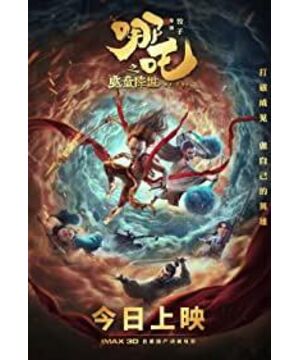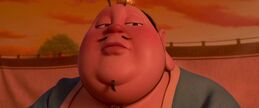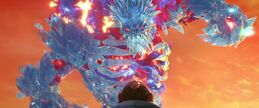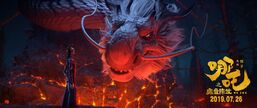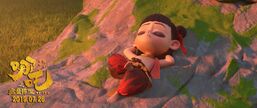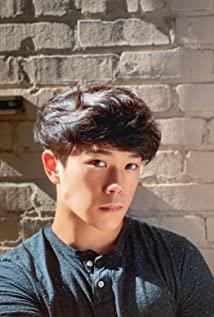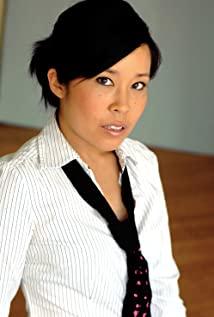In the summer of 40 years ago, "Nezha Naohai" was born.
This is China's first color wide-screen animated feature film, and it is also the first animation work featuring Nezha as the protagonist on the movie screen.
Nezha is probably the most recognizable character in the Chinese gods and demons story system, second only to Monkey King.
Before "Nezha Raising the Sea", there were countless works based on Nezha's prototype, which can be traced back to the ancient costume film "Nezha Raising the Sea" shot by Gu Wuwei, the founder of the Great China Film Company in 1927. In the following years, Nezha has always been a "popular IP" in film and television adaptations. Only Hong Kong director Ye Yisheng made three consecutive Nezha movies from 1948 to 1950.
In the 1960s, myths and legends were criticized as "big poisonous weeds". Until the end of the 1970s, the Shanghai Art Film Studio picked up the story of Nezha again. Zhang Yuanhua finally created "Nezha in the Sea", which brought the image of Nezha into the public eye again.
No matter from which point of view, the value of "Nezha Nao Hai" is of great importance to Chinese films and even world films. In 2014, in order to commemorate the 35th anniversary of the release of "Nezha Naohai", Ryan, the general manager of Google's Doodle team, also personally supervised the production of a commemorative logo.
However, what we must say today is that the image of Nezha in "Nezha in the Sea" is actually far from the real Nezha. To a certain extent, because it is too classic, it also affects the setting of Nezha in later film and television works. It was not until this summer, 40 years later, that "Nezha's Devil Child Comes into the World" was released, which reminded us of the Nezha who had been deviated too far.
Nezha, this is the name transliterated by Indian monks according to Sanskrit Buddhist scriptures. It first appeared in the middle and late Tang Dynasty, about 1200 years ago, after the story of "Twelve Hours in Chang'an" was set.
According to Buddhist scriptures, Nezha is the guardian deity of Buddhism, responsible for eradicating evil in the world, similar to "thugs". In other words, in Buddhism, the original image of Nezha is always ferocious and has nothing to do with cuteness, children, or heroes.
Until the end of Ming Dynasty, the novelist Xu Zhonglin creatively enriched the character image of Nezha in "Fengshen Romance".
The Nezha here is the reincarnation of Lingzhuzi, the guardian boy under the seat of the goddess Nuwa. He was appointed as the forerunner of the Western Zhou Dynasty, and his personality was explained from birth. After Nezha was born, the real Taiyi came to the door and said, " This son was born when he was ugly, and he is breaking the 1,700 precepts of killing."
Since he was in trouble at the age of 7, Nezha has repeatedly made troubles, killing Yaksa, pumping Ao Binglong tendons, beating the old dragon king, and shooting Niangniang Shiji and his disciples. He is a real "bear child". Although it was an unintentional act at first, it still affected the parents. In order to prevent the Dragon King of the Four Seas from taking his anger on his family, Nezha took the sword to his arm, and cut the abdomen, scraped the intestines, and removed the bones.
However, after the rebirth, Nezha's parent-child relationship changed dramatically. After his death, Nezha asked his mother to build a temple in a dream, so that his soul could be reborn into a human form. But his father, Li Jing, thought Nezha was an evil son, so he found the temple and burned it down. Nezha, who was reborn through the incarnation of the lotus flower, under the guidance of the real person Taiyi, stepped on the hot wheel and carried a fire-pointed gun to pursue and kill Li Jing for revenge, repeatedly refusing to accept discipline.
Xu Zhonglin completely cut off Nezha's connection with Buddhism in "Fengshen Romance", but her tyrannical temperament and murderous nature were reserved.
"Nezha Raising the Sea" is marked at the beginning of the film as being adapted from "Fengshen Romance", but in fact it is almost the exact opposite of the image of Nezha created by the latter.
Simply put, this animated film tells a story of pure good triumphing over evil. When Nezha saw righteousness and bravery, he formed a Liangzi with the Dragon King. He couldn't bear to see the people suffer, so he killed himself with grief and anger; Taiyi real person used the lotus root to restore Nezha's soul. After the reincarnation, Nezha's power is boundless, and he will fight against the dragon kings of the four seas and eliminate the harm for the people.
Director Wang Shuchen once wrote an article to explain the reasons for the adaptation: I hope the logic of the story is more reasonable and easier to be accepted by the public; it must have national characteristics and romanticism; it must maintain a mythological color without promoting negative thoughts.
Based on this principle, the creative team removed the settings of destiny and karma in the original work, and added drama to both the Dragon King and Nezha. For example, the story adds to the childish side of Nezha, highlights his daring, kind and lovely character, makes the audience sympathize, recognizes the character, and feels that it is a pity for Nezha to die and that his resurrection makes sense. When Nezha committed suicide, he picked up his sword in the violent storm and shouted, "Daddy, I will give you back your flesh and blood, I will not hurt you", which moved many audiences to tears.
In addition, the screenwriter also portrays the Dragon King camp as the incarnation of natural and man-made disasters, hoping that the audience hates the villain, and weakens the contradiction between Nezha and his father Li Jing, and does not develop the father-son relationship to the point of incompatibility: when Li Jing raises his sword to kill Nezha At that time, Nezha called out "Daddy", and his father immediately softened.
It must be admitted that under the background of the era at that time, the subversive adaptation of the original work of "Nezha Naohai" did make it accepted and loved by more people, and achieved great success, winning major film festivals at home and abroad. Several awards, becoming the first Chinese-language animated film to be exhibited in Cannes.
In the following 40 years, animation works about Nezha emerged one after another, and Nezha's artistic image was generally consistent with the modeling of "Nezha in the Sea", positive, brave, unyielding, lively and lovely.
For most of the post-90s generation, the most influential animation work about Nezha after "Nezha in the Sea" is probably "The Legend of Nezha".
This 52-episode large-scale cartoon produced by CCTV in 2003 pushed the image of Nezha to the peak of positive energy again: with the help of Nuwa and her friends, Xiao Nezha launched a thrilling struggle with Shiji, and overcome difficulties and difficulties. From an urchin who is not familiar with the world to a boy full of justice.
Compared with the animation itself, the more sung theme song "Youth Hero Nezha" directly shows the main creative team's positioning of Nezha's image: it's him, it's him, it's him, our hero Nezha.
In addition, the image of Nezha in TV series is not uncommon, from Nezha in the 1986 version of "Journey to the West" to Nezha played by Chen Haomin in the TVB version of "Fengshen Bang" in 2001, and then to Wu Lei's version of Nezha in 2006 ("Fengming Qishan of Fengshen Bang") and Song Zuer's version of Nezha in 2009 ("The Prequel to the Lotus Lantern"), they are all impressive.
However, after more than ten years, the children who watched the little Nezha have grown up, should we still be satisfied with a simple and beautiful image of the hero Nezha? What is the original spiritual core of Nezha's image?
This time, as soon as "Nezha's Devil Child Comes to the World" (hereinafter referred to as "Magic Child"), many people first saw this Nezha with smoky makeup, sharp teeth and a dignified child, and they felt that it was the lively and lovely one in their memory. The image of Nezha was very different, and he shouted that "the image of Nezha has been subverted".
actually not. In fact, this time Nezha is closer to the original work than in previous works, and the characters are finally no longer black and white.
Teacher Xu Zidong once mentioned in the "Round Table School" program that the easiest way to distinguish serious literature from popular literature is to see if there are "bad guys" in the works. As long as there is an obvious villain in the work, it is a melodrama. In a good work, the characters should not be set as half good and half bad, but you should see half good and half bad in everyone.
In "Fengshen Romance", Nezha was reincarnated as a spiritual bead, and in his life, he had "one thousand seven hundred killing precepts", but he also had the mission of protecting Zhou and destroying Shang, which in itself reflected Nezha's complex personality. Nezha in "Magic Boy" mistakenly became the reincarnation of the magic bead, and his origin was controversial. This is the valuable part of "Magic Child". The adaptation of the story makes the characters both good and evil, allowing the audience to see the side of Nezha who is often in trouble due to his rebellious and stubborn nature, and also depicts him being hostile and reviled since childhood. And the high wall he built, his sensitivity and cynicism are sincerely displayed.
Not only does Nezha's character have two sides, but so does Ao Bing. Ao Bing in "Magic Boy" was reincarnated as a Lingzhu, with extraordinary skills and politeness, but he shoulders the heavy responsibility of reviving the dragon clan, and his life experience as a "demon" makes him struggle between emotion and mission. He cherished the friendship he established with Nezha, and he was unwilling to live up to his father's trust; he chose to destroy the entire Chentang Pass in order to complete his mission, and fought side by side with Nezha at the final moment of crisis.
But the adaptation of "Magic Child" also has some differences from the original. Speaking of Nezha, another plot that is often mentioned by everyone is probably "suicide". This rebellious spirit is often used as an image, and it is reflected in many fields. For example, the band of pain admires Nezha as a kind of spiritual symbol.
I regret that Nezha appeared on the album covers and promotional posters of the band in the early days. Later, the image of Nezha committing suicide slowly became the band's logo.
Rebellious, cynical, fearless, and finally committed suicide, resurrected in the incarnation of lotus, reborn, and freed from bondage, Nezha is well-deserved by many people as the "spirit of rock and roll".
In the original work of "Fengshen Romance", Nezha is more resistant to patriarchy. From birth, Li Jing didn't like Nezha very much. The two clashed constantly. After Nezha was reborn as a lotus flower, he also confronted his father.
Jiang Xun once talked about Nezha when he described ethical loneliness in "Six Lectures on Solitude". When the lotus became his new body, he could betray his father. A betrayal is the feeling of loneliness under the repression of patriarchy and matriarchy.
"Parents are our greatest original sin, a debt that we can't pay in a lifetime, that is, we owe him flesh and blood, and we owe his blood, so when the novel describes Nezha cutting flesh to return his father and bone to his mother, it will give readers such a big shock. However, this role has been controversial in the past, and people dare not discuss him, because under the premise of "Hundreds of good and filial piety first", he is a lonely runaway. "
But in "Magic Child", this is completely modified. The relationship between Nezha and Li Jing has become a setting of "filial piety to the father and son", and this has also caused many comments that the story of Nezha has lost its depth from a certain point of view. At the birthday party, he finally found out about his magic pill's background. He felt isolated and deceived, and glared at his parents, but he looked more like a kind of rebellious and contradictory common among adolescents.
But in any case, we love the magic boy Nezha, because this is an unprecedented image of Nezha, a breakthrough and a return. We believe that this will be another epoch-making image of Nezha that can be recorded in the annals of Chinese film history after 40 years.
We imagine such a scene, if there is a Nezha image archive, when the devil boy Nezha looks up at his predecessors, will he feel so out of place: "Why am I different from them?"
Finally, an Amway is inserted:
In order to express our love for Nezha, we selected 10 images of Nezha with their own characteristics in the past 40 years. After all redesign and hand-painting, we made a set of cards (as shown in the picture above), and specially designed a Nezha image. Metal badges, you are welcome to pay attention to the "Reference Line" WeChat public account to buy.
Nezha Badge Set | Comes with 10 Nezha character hand-painted photo cards
Text | Edited by Cui Mengrong | Gao Haoyuan
Illustrator | Ye Nan Seventeen and Seven
All pictures and texts in this article are copyrighted by Reference Line™️ (except for data maps). If you need to reprint, please leave a message. Unauthorized use or modification is strictly prohibited.
References: [1] Script adaptation and screen representation of "Nezha in the Sea" | Wang Shuchen[2] Beyond the animated film "Nezha": When did Nezha become a child | Sledgehammer says history[3] Why is the logo of the band Pain Yang Nezha? Let's make a guess that is closest to the answer | Life Fan Faner [4] Who is Nezha? He is not a magic pill or a spirit bead, he is my son first! | 嘚嘚嘚嘚
View more about Ne Zha reviews


